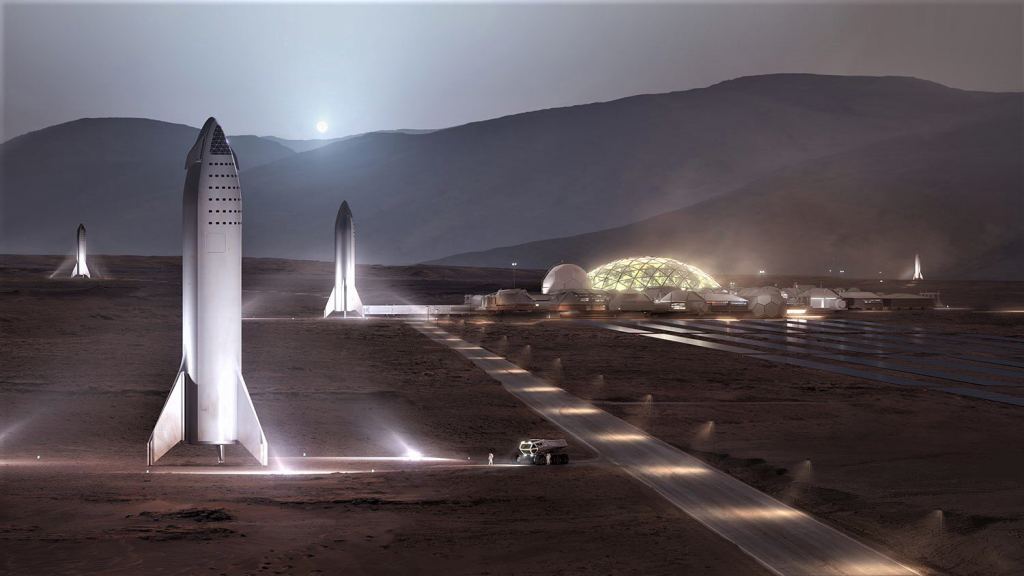The design for SpaceX’s Starship (aka. Big Falcon Rocket) is really starting to come together! Over the holidays, sections of the Starship Hopper (a miniature version of the Starship) were photographed being put together at the company’s South Texas Launch Site. By mid-January, the parts were fully-integrated, forming the body of the stainless-steel prototype that would test the spacecraft’s overall architecture.
What followed, earlier this month, were tests of the Starship’s hexagonal heat shields to determine if they would offer sufficient protection during re-entry. And now, in anticipation of the spacecraft’s eventual launch, SpaceX released an eye-popping new rendering of the Starship that shows what it would look like reentering Earth’s atmosphere.
This is the first detailed rendering of the Starship, which was created for the cover of the April 2019 issue of Popular Mechanics. The render was only been made available in print and through a single publication, but Teslarati managed to acquire a partial-resolution copy, which they proceeded to publish on their website for the general public to see.
The render offers a beautiful impression of how the Starship’s design will look surrounded by plasma. It also calls to mind the hexagonal-tile heat shield that will ensure the reusable spacecraft can survive repeated reentries. According to Musk’s statement, these steel tiles will reinforce the sections of the spacecraft that experience the most heating as a result of atmospheric drag.
Musk also indicated that transpiration cooling would be used, a process that involves passing a coolant through the wall of a heated surface to prevent it from eroding. Or as Musk explained in a recent tweet, “Transpiration cooling will be added wherever we see erosion of the shield. Starship needs to be ready to fly again immediately after landing. Zero refurbishment.”
In this case, the coolant would be some of the Starship’s own liquid methane propellant, which would be channeled through the steel skin and out through a series of tiny holes. The liquid methane would quickly vaporize into a gas and then become plasma as it entered the spacecraft’s superheated bow shock, reducing the heat load on certain sections of the tile.
The addition of this vaporized methane would also result in a plasma “tail” that is richly colored. Essentially, the color of a plasma tail is the result of spacecraft materials interacting with super-hot plasma. In the case of ablative shielding, this is caused by the injection of different elements into the compressed air around the ship, which are brightly-colored as a result of their particular chemical composition.

This may have been the idea behind a second image, which was also provided only to Popular Mechanics, that features a wider-angle view of the Starship entering Mars’ atmosphere. Luckily, Reddit user WibloBaggins recently uploaded what is purported to be this image (shown below) to Reddit. As you can see, the image features the Starship creating a multi-colored plasma tail as it passes into Mars’ atmosphere.
This may or may not be an intentional representation of what the Starship’s plasma tail will look like as it enters Mars’ atmosphere. Much like carbon dioxide, methane burns blue when subjected to extreme heat – in methane’s case, temperatures above 1960 °C (3560 °F). Since Mars’ atmosphere is predominantly composed of CO2 and methane, the depiction of a tail ranging from light blue/indigo to red/white seems highly plausible.
In any case, once it is finished testing and integrated into the design of the Starship, this heat shield will be one of few in the history of spaceflight that experiences no ablation and therefore has no need for refurbishment. The only other spacecraft to employ similar heat shield technology was NASA’s Space Shuttle, which relied on a reusable tile shield made of insulating material.
Known as the Thermal Protection System (TPS), this shield was made up of LI-900 silicate ceramic tiles, fibrous refractory composite insulation tiles (FRCI), toughened unipiece fibrous insulation (TUFI) tiles, Nomex insulation blankets, and reinforced carbon-carbon (RCC) surfaces for the nose cap and leading edges of the wings
For comparison, the Orion Multi-purpose Crew Vehicle (MPCV) relies on an ablative heat shield that is composed of Avcoat, a heat-retardant substance similar to what the Apollo missions used (sans toxic materials like asbestos). Similarly, SpaceX’s Crew and Cargo Dragon capsules rely on ablative heat shields, known as the PICA-X system.
While these materials are extremely heat-resistant – in the case of the Orion heat shield, able to withstand temperatures of up to 2200 °Celsius (4000 °Fahrenheit) – the fact that they need to be refurbished afterwards makes them a poor choice for reusable spacecraft. By creating an integrated system that requires very little maintenance, SpaceX is delivering on its promise for creating a fully-reusable system.
These images are also in keeping with Musk’s promise that once complete, the Starship will conduct regular commercial missions to orbit, the Moon, and eventually to Mars. In the case of Earth-bound missions, these flights will reportedly be dedicated to the deployment of satellites and cargo, as well as the possibility of intercontinental commercial flights.
The Martian missions, on the other hand, will focus on the transport of crews and cargo as part of a space tourism venture – ostensibly to finance further development of the Starship and its launch vehicle (the Super Heavy). According to previous statements by Musk, one of the long-term goals is to create a permanent base on Mars (Mars Base Alpha) by 2028, which he shared a rendering of back in September.

In the meantime, SpaceX has reportedly commenced testing the Starship Hopper at their South Texas Launch Site this week. According to another statement previously made by Musk, the company hopes to finish construction of a full-scale orbital prototype by this summer as well.
It is no exaggeration to say that an awful lot hinges on the successful completion of these tests; not just for SpaceX, but for the commercial space industry (aka. NewSpace) as a whole. With everything from space tourism and the ability to launch super-heavy payloads into orbit for a fraction of the price, there is no shortage of people hoping that Elon Musk and the Starship will succeed!
Further Reading: Teslerati

